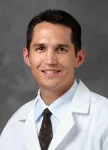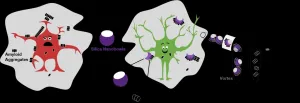(Press-News.org) Memphis, Tenn. (February 25, 2021) - Early diagnosis of Alzheimer's disease has been shown to reduce cost and improve patient outcomes, but current diagnostic approaches can be invasive and costly. A recent study, published in the Journal of Alzheimer's Disease, has found a novel way to identify a high potential for developing Alzheimer's disease before symptoms occur.
Ray Romano, PhD, RN, completed the research as part of his PhD in the Nursing Science Program at the University of Tennessee Health Science Center College of Graduate Health Sciences. Dr. Romano conducted the research through the joint laboratory of Associate Professor Todd Monroe, PhD, RN, at The Ohio State University, who is also a graduate of the UTHSC Nursing Science PhD Program, and Ronald Cowan, MD, PhD, who is the chair of Psychiatry at UTHSC. The study is titled, "Could altered pain responsiveness be a phenotypic biomarker for Alzheimer's risk? A cross-sectional analysis of cognitively healthy adults."
Dr. Romano said, "There is a real need to find ways to diagnose Alzheimer's disease in the primary care setting, where most patients first present with concerns for their memory." Dr. Romano earned his PhD in Nursing Science at UTHSC in 2020.
The research found that cognitively healthy people at increased genetic risk of late-onset Alzheimer's disease showed significantly lower sensitivity to thermal pain, but felt greater unpleasantness related to that pain when compared to people at lower risk of the disease. These results suggest that altered pain perception could potentially be used as a biomarker of late-onset Alzheimer's disease before symptoms occur.
Previous research had identified a specific genetic allele, APOE4, as a marker associated with an increased incidence of developing late-onset Alzheimer's disease. In his groundbreaking study, Dr. Romano was able to identify individuals who were cognitively healthy but had the APOE4 allele. He was then able to determine whether people with the APOE4 allele responded differently to experimentally induced painful stimuli than did cognitively healthy individuals who did not have this allele.
Dr. Cowan noted, "This work also highlights the great strength of joint collaborations between nursing and psychiatry, which have been highly productive for our research programs."
The study included 49 cognitively healthy adults aged 30-89. Twelve of the subjects had the APOE4 allele, and 37 did not. They were assessed for group differences in pain thresholds and feelings of unpleasantness in response to experimentally induced thermal pain stimuli.
Use of this biomarker to identify people at risk of Alzheimer's disease before the onset of serious symptoms would be much less invasive than other methods of Alzheimer's diagnosis, which include lumbar punctures and positron emission topography (PET) scans. These are expensive tests that are not practical in primary care settings.
"In this exploratory study, Dr. Romano demonstrated that healthy adults with a specific gene for developing late-stage Alzheimer's disease experience pain differently than people without the genetic marker," Dr. Monroe said. "Next, we need to examine the brain's pain systems to determine why this may be occurring. If future studies confirm these results, findings may eventually translate into earlier screening in people at risk of developing Alzheimer's disease leading to more treatment options."
INFORMATION:
Approximately 5.8 million people in the United States live with Alzheimer's disease - the sixth-leading cause of death in the country, according to the Alzheimer's Association. It is estimated that 500,000 new cases of the disease are diagnosed in the U.S. annually.
As Tennessee's only public, statewide, academic health system, the mission of the University of Tennessee Health Science Center is to bring the benefits of the health sciences to the achievement and maintenance of human health through education, research, clinical care, and public service, with a focus on the citizens of Tennessee and the region. The main campus in Memphis includes six colleges: Dentistry, Graduate Health Sciences, Health Professions, Medicine, Nursing, and Pharmacy. UTHSC also educates and trains medicine, pharmacy, dentistry, and health professions students, as well as medical residents and fellows, at major sites in Knoxville, Chattanooga, and Nashville. For more information, visit http://www.uthsc.edu. Find us on Facebook: facebook.com/uthsc, Twitter: twitter.com/uthsc, LinkedIn: linkedin.com/uthsc, and Instagram: instagram.com/uthsc.
DETROIT (February 25, 2021) - Researchers at Henry Ford Health System, as part of a national asthma collaborative, have identified a gene variant associated with childhood asthma that underscores the importance of including diverse patient populations in research studies.
The study is published in the print version of the American Journal of Respiratory and Critical Care Medicine.
For 14 years researchers have known that a casual variant for early onset asthma resides on chromosome 17, which holds one of the most highly replicated and significant genetic associations with asthma. Henry Ford researchers acknowledged they would not have identified it in this study ...
ROCKVILLE, MD - Scientists are still a long way from being able to treat Alzheimer's Disease, in part because the protein aggregates that can become brain plaques, a hallmark of the disease, are hard to study. The plaques are caused by the amyloid beta protein, which gets misshapen and tangled in the brain. To study these protein aggregates in tissue samples, researchers often have to use techniques that can further disrupt them, making it difficult to figure out what's going on. But new research by Vrinda Sant, a graduate student, and Madhura Som, a recent PhD graduate, in the lab of Ratnesh Lal at the University of California, San Diego, provides a new technique for studying amyloid beta and could be useful in future Alzheimer's treatments. Sant and her colleagues will present their research ...
Our use of social media, specifically our efforts to maximize "likes," follows a pattern of "reward learning," concludes a new study by an international team of scientists. Its findings, which appear in the journal Nature Communications, reveal parallels with the behavior of animals, such as rats, in seeking food rewards.
"These results establish that social media engagement follows basic, cross-species principles of reward learning," explains David Amodio, a professor at New York University and the University of Amsterdam and one of the paper's authors. "These findings may help us understand why social media comes to dominate daily life for many people and provide clues, borrowed from research on reward learning and addiction, to how troubling online engagement may ...
Chemical engineering researchers have developed a new catalyst that significantly increases yield in styrene manufacturing, while simultaneously reducing energy use and greenhouse gas emissions.
"Styrene is a synthetic chemical that is used to make a variety of plastics, resins and other materials," says Fanxing Li, corresponding author of the work and Alcoa Professor of Chemical Engineering at North Carolina State University. "Because it is in such widespread use, we are pleased that we could develop a technology that is cost effective and will reduce the environmental impact of styrene manufacturing." Industry estimates ...
The koala retrovirus (KoRV) is a virus which, like other retroviruses such as HIV, inserts itself into the DNA of an infected cell. At some point in the past 50,000 years, KoRV has infected the egg or sperm cells of koalas, leading to offspring that carry the retrovirus in every cell in their body. The entire koala population of Queensland and New South Wales in Australia now carry copies of KoRV in their genome. All animals, including humans, have gone through similar "germ line" infections by retroviruses at some point in their evolutionary history and contain many ancient retroviruses in their genomes. These retroviruses have, over millions of years, mutated into degraded, inactive forms that are no longer harmful to the host. Since in most animal ...
NARRAGANSETT, R.I. - February 26, 2021 - A team of researchers from the University of Rhode Island's END ...
When a muscle grows, because its owner is still growing too or has started exercising regularly, some of the stem cells in this muscle develop into new muscle cells. The same thing happens when an injured muscle starts to heal. At the same time, however, the muscle stem cells must produce further stem cells - i.e., renew themselves - as their supply would otherwise be depleted very quickly. This requires that the cells involved in muscle growth communicate with each other.
Muscle growth is regulated by the Notch signaling pathway
Two years ago, a team of researchers led by Professor Carmen Birchmeier, head of the Developmental Biology/Signal Transduction ...
A new study shows that a widespread decline in abundance of emergent insects - whose immature stages develop in lakes and streams while the adults live on land - can help to explain the alarming decline in abundance and diversity of aerial insectivorous birds (i.e. preying on flying insects) across the USA. In turn, the decline in emergent insects appears to be driven by human disturbance and pollution of water bodies, especially in streams. This study, published in END ...
Who would have thought that a small basic compound like vitamin B6 in the banana or fish you had this morning may be key to your body's robust response against COVID-19?
Studies have so far explored the benefits of vitamins D and C and minerals like zinc and magnesium in fortifying immune response against COVID-19. But research on vitamin B6 has been mostly missing. Food scientist END ...
HDL cholesterol (high-density lipoprotein cholesterol) or good cholesterol is associated with a decreased risk of cardiovascular disease as it transports cholesterol deposited in the arteries to the liver to be eliminated. This contrasts with the so-called bad cholesterol, LDL (low-density lipoprotein cholesterol), which causes cholesterol to accumulate in the arteries and increases cardiovascular risk. Although drugs that lower bad cholesterol reduce cardiovascular risk, those that raise good cholesterol have not proven effective in reducing the risk of heart disease. This paradox has called into question the ...





